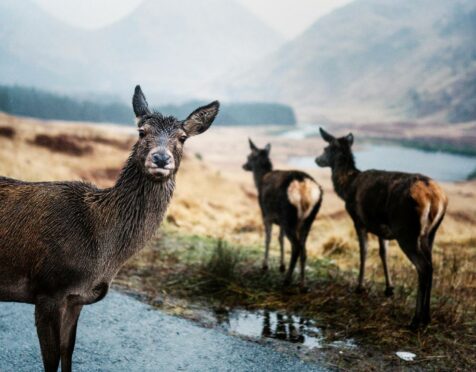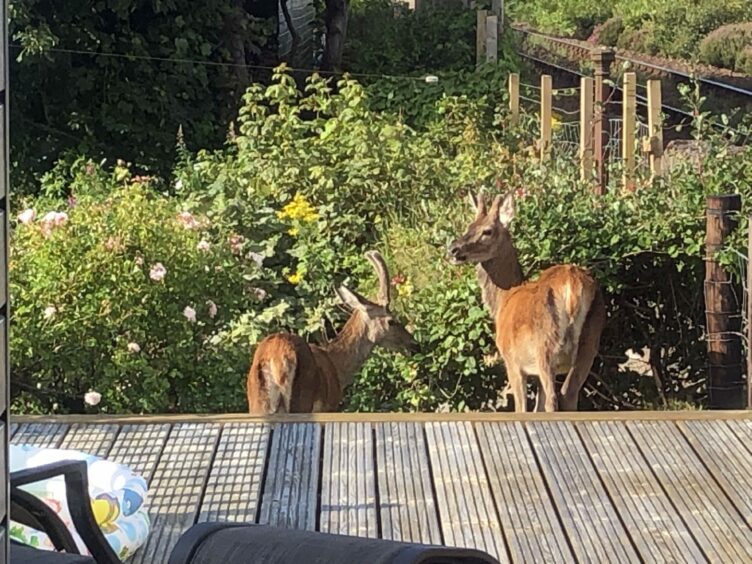Residents of a Highland village have been warned to stop hand-feeding wild deer that live in and around the area.
The advice comes following reports of attacks on people and dogs as well as a rise in Lyme disease cases in Kinlochleven.
Experts are urging people not to approach the deer, as they fear that frequent interactions with humans will decrease their natural instincts.
A herd of red deer is thought to have set up home in the village having been seen frequently there, even venturing in to a local playpark.
A spokeswoman for NatureScot told The Herald: “We’re particularly concerned by evidence of local people feeding the deer, which causes them to lose their natural fear of humans.
“This can result in greater risk of deer and vehicle collisions, deer approaching people expecting food, and stags becoming more aggressive, especially around the rut.
“To reduce these risks we are urging people to leave the deer alone, and let them forage naturally.”
‘Simple pleasure of being close to beautiful animals’
Some members of the community in Kinlochleven see the deer as more of a novelty than a worry.
One said: “There are some residents who don’t think it’s a problem. Everyone is worried that someone is going to get hurt. Deers carry ticks and we’ve got a lot of Lyme Disease in the village.
“I think it comes down to that simple pleasure of being close to beautiful animals and maybe people forget that they can be wild and dangerous.”
Scotland has the highest number of cases of Lyme disease, which can lead to long-term health complications if contracted.
The Scottish variant of the disease is thought to cause more neurological problems including severe headaches, meningitis, temporary paralysis of the facial muscles and poor motor coordination.
‘They are wild animals and should be treated accordingly’
Kinlochleven Community Trust is working with NatureScot along with police and landowners to raise awareness of the problem.
A spokesperson said: “We are concerned about the health and safety of our community and the deer themselves.
“It is becoming increasingly apparent that the current position will not be improved until the residents that are feeding deer stop this behaviour. They are wild animals and should be treated accordingly.
“Domesticating them is effectively putting them at risk by feeding them an inappropriate diet, encouraging them to live in urban environments and reducing their fear of humans.”
Deer attack
The Kinlochleven Community Trust warned locals of the dangers of approaching deer in a post on their Facebook page after a resident was “almost attacked”.
They said: “We have been informed that a resident in the village was almost attacked by a deer this morning. Luckily, no injuries were sustained.”
In another post, the group highlighted the fact that accidents and injuries could happen more if people are not careful.
They said: “We have had troubling reports of incidents involving deer. The board have asked us to catalogue any negative impact this may be creating to get a better idea of the situation.
“There is a growing worry that this behavior (feeding the deer) may cause a serious incident or accident involving deer, people, vehicles, children and/or pets.
“I’m sure you’ll all agree that no amount of selfies, close-up experiences or feeding encounters with deer are worth a serious injury or hospitalisation.”
Meanwhile in Mallaig
Kinlochleven is not the only area that has been visited by deer in recent months.
Deer numbers in Mallaig have been deemed “too high” and locals have complained that the port is overrun by deer from Sir Cameron Mackintosh’s Nevis Estate.
NatureScot stepped in and ordered the musical mogul to organise a cull, with deer numbers in his estate now a “threat to public safety”.
Andrew Aitchison, who works on the estate, insisted the matter was being taken seriously.
He said: “He understands what needs to be done and wanted to ensure all parties were comfortable for it to be undertaken. He is supportive of us getting on and doing it.
“He’s doing as a responsible landowner should be doing – cooperating and communicating with the local community and the statutory bodies.”

